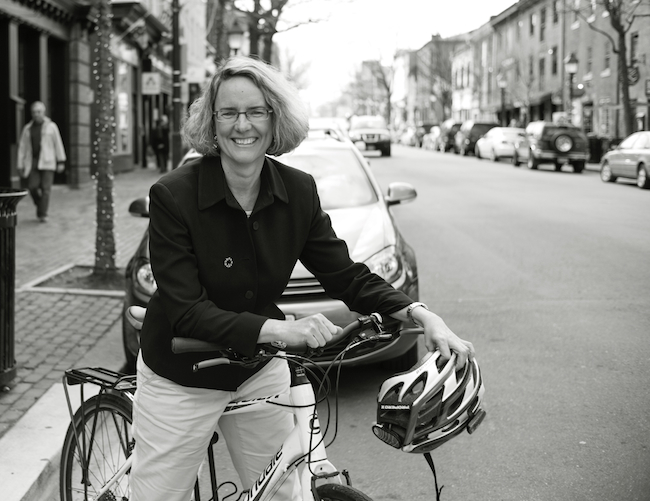
On June 4, when the Congress for the New Urbanism (CNU) begins its annual meeting in Buffalo, a new president, Lynn Richards, will greet its members. Richards spent 14 years working for the Environmental Protection Agency in Washington before moving to the Chicago-based nonprofit. (She officially takes over from former Milwaukee mayor John O. Norquist on July 1.)
Richards, 47, arrives at the CNU on the heels of a withering critique by author Witold Rybczynski, who wrote on his blog that “while new urbanists have attempted to shed their small town/suburban/Truman Show image, they have had no similarly successful and exemplary big-city project. No High Line. No Disney Hall. No Fifteen Central Park West.” He concluded with a list of urban trends—from charter schools to community gardens—that he believes New Urbanism missed. Richards will have to try to correct that perception, along with the perception that the movement is about retro architectural styling—the product, in part, of its association with Seaside designers Andres Duany and Elizabeth Plater-Zyberk. (Duany, Plater-Zyberk and four others founded the CNU in 1993.) Still, this should be a very good time to lead the 3,000-member organization, with polls—and real estate prices—showing a substantial number of Americans rejecting the suburban "ideal" in favor of urban, transit-oriented communities. Though she expects to spend her first months at the CNU "just listening," Richards spoke with Record about her new responsibilities.
What did you think of Rybczynski’s critique?
I read it and immediately rejected it. We have influenced the national conversation about where and how communities develop. Don’t you think it’s our members suggesting the initiatives he listed to local officials? We’re busy doing the work, not shouting about it from the rooftops.
And the idea that the CNU is about a certain kind of architecture?
We’re not about imposing a style. The last thing we want to do is replace a generic strip mall with a generic town center. In the next generation of development, we want to identify and celebrate the characteristics that make individual neighborhoods special.
And how will you deal with the organization’s bold-faced names?
I want to respect the work they have done. CNU is at a point where it can stand on the shoulders of its founders and build off all of their good work.
How does your regulatory background fit the job?
A big part of what CNU does is address regulations that directly affect what gets built. On the local level, you’re seeing prohibitions on higher density, you’re seeing prohibitions on mixed-use development, and you’re seeing prohibitions on accessory dwelling units. You’re seeing minimum acreage standards for schools, and minimum setback requirements for houses. Our members are on the front lines; as architects, engineers, planners, consultants, and developers, they’re the first to uncover the barriers to why more great places can’t be built.
And is Washington, where you’ve been working until now, supportive of New Urbanist principles?
The federal government subsidizes low-density, dispersed development to the tune of $450 billion a year. It’s hard for an outside organization to turn that around. But we have had successes at the federal level. For example, Fannie Mae, HUD, FHA, and Freddie Mac have regulations limiting the amount of commercial space in mixed-use buildings. Last year CNU worked with FHA to shift that percentage from 25 to 35, with possible waivers up to 50 percent. Now that FHA has changed its regulations, we hope to do the same with HUD, Fannie, and Freddie.
So you’re opposed to regulation?
There are areas, such as affordable housing, where you need regulation. The market will never respond by building the number of affordable housing units that we need. So if you want a vibrant place, you’re going to need inclusionary zoning, density bonuses, absolutely. But what about the rule that streets have to be 35 feet wide, essentially requiring neighborhood streets that are unsafe for anything but cars? That type of regulation can have huge unintended consequences.
Do you want people to live in urban centers?
It’s about choice. Fifty percent of Americans want to live in a suburban environment at some point in their lives, and that’s fine. But many baby boomers and millenials are seeking a more urban, sustainable experience. They want to have the option to walk or bike or take transit to work. But building those communities is still illegal in some places. Right now, it’s easier to cut down a forest and put up houses than to build in the center of town. We just want to level the playing field.
What did you do in your 14 years at the EPA that prepared you for this job?
What I’m most known for is framing the national debate around density and storm water management. Some cities and states require detention ponds of a certain size, based on the square footage of new construction, for flood control. But if you’re going to put a 10-story building where there’s a parking lot, which is already 100 percent impervious cover, there’s going to be no net increase in runoff. So the requirement for managing storm water should be reduced for some beneficial development types.
How does this affect the design of cities?
A detention pond in your central business district breaks up the urban form, by putting space between destinations. You create an area that becomes less walkable, less livable. So what I did was suggest changes to federal, state, and local standards that would capture the inherent storm water management benefit of redevelopment.
So you’re a policy wonk?
Sometimes, you have to be in the weeds. It’s important that we systematically identify the barriers to building great places and do everything we can to change them.




Post a comment to this article
Report Abusive Comment